 W
WThe Spanish–American War was an armed conflict between Spain and the United States in 1898. Hostilities began in the aftermath of the internal explosion of USS Maine in Havana Harbor in Cuba, leading to U.S. intervention in the Cuban War of Independence. The war led to the U.S. emerging predominant in the Caribbean region, and resulted in U.S. acquisition of Spain's Pacific possessions. That led to U.S. involvement in the Philippine Revolution and ultimately to the Philippine–American War.
 W
WThe timeline of events of the Spanish–American War covers major events leading up to, during, and concluding the Spanish–American War, a ten-week conflict in 1898 between Spain and the United States of America.
 W
WThe Ten Years' War (1868–1878), also known as the Great War and the War of '68, was part of Cuba's fight for independence from Spain. The uprising was led by Cuban-born planters and other wealthy natives. On October 10, 1868 sugar mill owner Carlos Manuel de Céspedes and his followers proclaimed independence, beginning the conflict. This was the first of three liberation wars that Cuba fought against Spain, the other two being the Little War (1879–1880) and the Cuban War of Independence (1895–1898). The final three months of the last conflict escalated with United States involvement, leading to the Spanish–American War.
 W
WA black legend is a historiographical phenomenon in which a sustained trend in historical writing of biased reporting and introduction of fabricated, exaggerated and/or decontextualized facts is directed against particular persons, nations or institutions with the intention of creating a distorted and uniquely inhuman image of them while hiding their positive contributions to history. The term was first used by French writer Arthur Lévy in his 1893 work Napoléon Intime, in contrast to the expression "Golden Legend" that had been in circulation around Europe since the publication of a book of that name during the Middle Ages.
 W
WThe Black Legend, or the Spanish Black Legend, is a theorised historiographical tendency consisting of anti-Spanish and anti-Catholic propaganda. Its proponents claim that its roots date back to the 16th century, when it was originally a political and psychological weapon that was allegedly used by Spain's northern European rivals in order to demonize the Spanish Empire, its people and culture, minimize Spanish discoveries and achievements, and counter its influence and power in world affairs.
 W
WBuffalo Soldiers originally were members of the 10th Cavalry Regiment of the United States Army, formed on September 21, 1866, at Fort Leavenworth, Kansas. This nickname was given to the Black Cavalry by Native American tribes who fought in the Indian Wars. The term eventually became synonymous with all of the African-American regiments formed in 1866:9th Cavalry Regiment 10th Cavalry Regiment 24th Infantry Regiment 25th Infantry Regiment Second 38th Infantry Regiment
 W
WCamp Alger, near Falls Church, Virginia, was established May 18, 1898, for the Spanish–American War effort. It was approved by Secretary of War Russell A. Alger for whom it was named. By August 1898, more than 35,000 troops were stationed at the camp.
 W
WCamp Lockett was a United States Army military post located in Campo, California, east of San Diego, and north of the Mexican border. Camp Lockett has historical connections to the Buffalo Soldiers due to the 10th and 28th Cavalry Regiments having been garrisoned there during World War II. It was named in honor of Colonel James R. Lockett who fought in the Spanish–American War, Philippine Insurrection, and the Punitive Expedition. There was an active preservation effort underway with long term plans of creating the 'Camp Locket Historic District' in the National Register of Historic Places, which ended due to private property concerns. In 2009 it was designated as a California Historical Landmark, and there are plans to create a county park out of the majority of its former area.
 W
WCamp Merriam, California was a U.S. military camp for American troops destined for the Philippines during the Spanish–American War. Located at the San Francisco Presidio, the camp, named after Major General Henry C. Merriam, the Commanding General of the Department of the Pacific. Camp Merriam was located on the hills just north of the Lombard Street entrance to the Presidio of San Francisco. The camp was established in 1898 to quarter and train volunteer soldiers from California, Iowa, Kansas, and South Dakota for service during in the Spanish-American War.
 W
WCamp Merritt, California was a U.S. military camp used for the quartering and preparation of American troops destined for the Philippines during the Spanish–American War. Formerly a racetrack, it was named for General Wesley Merritt, the commanding general of the U.S. Voluntary Army forces and the Eighth Army Corps. The camp was located in San Francisco, California in an area approximately bounded by what is now Point Lobos Avenue (Geary), Fulton Street, First (Arguello) and Sixth Streeets.
 W
WMontauk County Park, formerly known as Theodore Roosevelt County Park, is located approximately three miles (4.8 km) east of Montauk, New York. The park is 1,157 acres (4.68 km2) in size, running from Montauk Highway north to Block Island Sound and is bordered on the east by Montauk Point State Park.
 W
WCarl Evert Nathorst, , was a Swedish soldier, living in the Philippines from 1898 to his death in 1945.
 W
WThe Cuban War of Independence was the last of three liberation wars that Cuba fought against Spain, the other two being the Ten Years' War (1868–1878) and the Little War (1879–1880). The final three months of the conflict escalated to become the Spanish–American War, with United States forces being deployed in Cuba, Puerto Rico, and the Philippine Islands against Spain. Historians disagree as to the extent that United States officials were motivated to intervene for humanitarian reasons but agree that yellow journalism exaggerated atrocities attributed to Spanish forces against Cuban civilians.
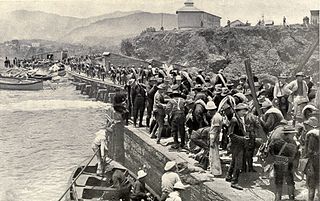 W
WDaiquirí is a small village, 14 miles east of Santiago de Cuba. It became a focal point of the United States invasion of Cuba in the Spanish–American War.
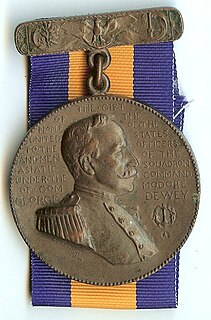 W
WThe Dewey Medal was a military decoration of the United States Navy which was established by the United States Congress on June 3, 1898. The medal recognizes the leadership of Admiral of the Navy George Dewey, during the Spanish–American War, and the Sailors and Marines under his command.
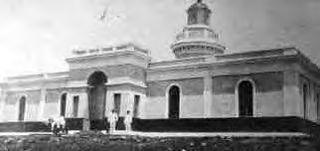 W
WThe Battle of Fajardo was an engagement between the armed forces of the United States and Spain that occurred on the night of August 8–9, 1898 near the end of the Puerto Rican Campaign during the Spanish–American War.
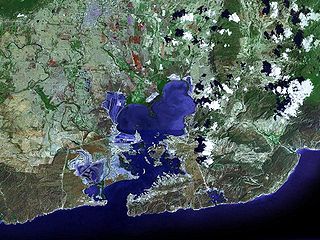 W
WGuantánamo Bay is a bay located in Guantánamo Province at the southeastern end of Cuba. It is the largest harbor on the south side of the island and it is surrounded by steep hills which create an enclave that is cut off from its immediate hinterland.
 W
WGuantanamo Bay Naval Base, officially known as Naval Station Guantanamo Bay or NSGB, is a United States military base on the shore of Guantánamo Bay and is also the oldest overseas U.S. Naval Base. The base is located on 45 square miles (116 km2) of land and water at Guantánamo Bay, at the southeastern end of Cuba, which the U.S. leased for use as a coaling station and naval base in 1903. The lease was $2,000 in gold per year until 1934, when the payment was set to match the value in gold in dollars; in 1974, the yearly lease was set to $4,085.
 W
WThe Hong Kong Junta was an organization formed as a revolutionary government in exile by Filipino revolutionaries after the signing of the Pact of Biak-na-Bato on December 15, 1897. It was headed by Emilio Aguinaldo and included high-level figures in the Philippine revolution against Spanish rule who accompanied Aguinaldo into exile in the Crown Colony of Hong Kong from the Philippines.
 W
WU.S.S. Maine was a United States Navy ship that sank in Havana Harbor in February 1898, contributing to the outbreak of the Spanish–American War in April. American newspapers, engaging in yellow journalism to boost circulation, claimed that the Spanish were responsible for the ship's destruction. The phrase, "Remember the Maine! To hell with Spain!" became a rallying cry for action. Although the Maine explosion was not a direct cause, it served as a catalyst that accelerated the events leading up to the war.
 W
WA Message to Garcia is a widely distributed essay written by Elbert Hubbard in 1899, expressing the value of individual initiative and conscientiousness in work. As its primary example, the essay uses a dramatized version of a daring escapade performed by an American soldier, 1st Lt. Andrew S. Rowan, just prior to the Spanish–American War. The essay describes Rowan carrying a message from President William McKinley to "Gen. Calixto García, a leader of the Cuban insurgents somewhere in the mountain vastness of Cuba—no one knew where". The essay contrasts Rowan's self-driven effort against "the imbecility of the average man—the inability or unwillingness to concentrate on a thing and do it".The point I wish to make is this: McKinley gave Rowan a letter to be delivered to Garcia; Rowan took the letter and did not ask, "Where is he at?" By the Eternal! there is a man whose form should be cast in deathless bronze and the statue placed in every college of the land. It is not book-learning young men need, nor instruction about this and that, but a stiffening of the vertebrae which will cause them to be loyal to a trust, to act promptly, concentrate their energies: do the thing- "Carry a message to Garcia!"
 W
WThe Militia Act of 1903, also known as the Efficiency in Militia Act of 1903 or the Dick Act, was legislation enacted by the United States Congress to create an early National Guard and which codified the circumstances under which the Guard could be federalized. It also provided federal funds to pay for equipment and training, including annual summer encampments. The new National Guard was to organize units of similar form and quality to those of the regular Army, and intended to achieve the same training, education, and readiness requirements as active duty units.
 W
WThe Monroe Doctrine was a United States policy that opposed European colonialism in the Americas. It argued that any intervention in the politics of the Americas by foreign powers was a potentially hostile act against the United States. It began in 1823; however, the term "Monroe Doctrine" itself was not coined until 1850.
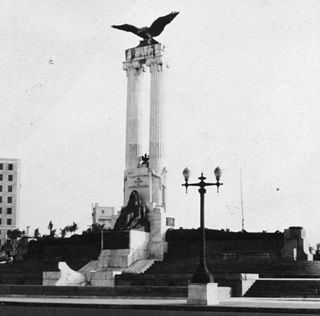 W
WThe Monument to the Victims of the USS Maine was built in 1925 on the Malecón boulevard at the end of Línea Calle, in the Vedado neighborhood of Havana, Cuba.
 W
WOn March 2, 1901, the Platt Amendment was passed as part of the 1901 Army Appropriations Bill. It stipulated seven conditions for the withdrawal of United States troops remaining in Cuba at the end of the Spanish–American War, and an eighth condition that Cuba sign a treaty accepting these seven conditions. It defined the terms of Cuban–U.S. relations essentially to be an unequal one of U.S. dominance over Cuba.
 W
WThe Spanish–American War is considered to be both a turning point in the history of propaganda and the beginning of the practice of yellow journalism.
 W
WThe Puerto Rico Campaign was the American military sea and land operation on the island of Puerto Rico during the Spanish–American War. The offensive began on May 12, 1898, when the United States Navy attacked the capital, San Juan. Though the damage inflicted on the city was minimal, the Americans were able to establish a blockade in the city's harbor, San Juan Bay. On June 22, the cruiser Isabel II and the destroyer Terror delivered a Spanish counterattack, but were unable to break the blockade and Terror was damaged.
 W
WRayadillo was a blue-and-white striped cotton fabric used to make the military uniforms worn by Spanish colonial soldiers from the mid 19th century until the early 20th Century. Known by the British as "pyjamas", due to their resemblance with sleeping garments, it was commonly worn amongst soldiers posted in overseas Spanish tropical colonies and later, Spanish Morocco and Spanish Guinea. It became popular after being worn during the Spanish–American War, and was later adopted by the Philippine Army. It also served as the summer uniform of the regular army in Spain until 1914.
 W
WThe Sampson Medal is a commemorative medal of the United States Navy for service in the Spanish–American War. The medal was authorized by an Act of Congress in 1901. The medal was awarded to those personnel who served on ships in the fleet of Rear Admiral William T. Sampson during combat operations in the waters of the West Indies and Cuba. The Sampson Medal was also known as the Medal Commemorating Naval Engagements in the West Indies or West Indies Naval Campaign Medal, not to be confused with the West Indies Campaign Medal which was a separate award. A similar commemorative decoration was the Dewey Medal, considered senior to the Sampson Medal.
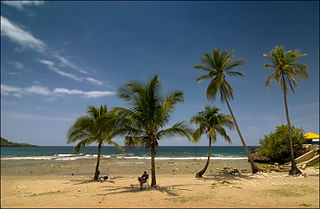 W
WSiboney is a Cuban village and consejo popular located in the east of the city of Santiago de Cuba and belonging to its municipality.
 W
WSociety of the Army of Santiago de Cuba was an organization, the purpose of which was to record the history and conserve the memory of the events of the campaign which resulted in the surrender, on July 17, 1898, of the Spanish army, the city of Santiago de Cuba, and the military province to which it pertained during the Spanish–American War.
 W
WThe Teller Amendment was an amendment to a joint resolution of the United States Congress, enacted on April 20, 1898, in reply to President William McKinley's War Message. It placed a condition on the United States military's presence in Cuba. According to the clause, the U.S. could not annex Cuba but only leave "control of the island to its people." In short, the U.S. would help Cuba gain independence and then withdraw all its troops from the country.
 W
W"A Hot Time in the Old Town", also titled as "There’ll Be a Hot Time in the Old Town Tonight", is an American popular song, copyrighted and perhaps composed in 1896 by Theodore August Metz with lyrics by Joe Hayden. Metz was the band leader of the McIntyre and Heath Minstrels.
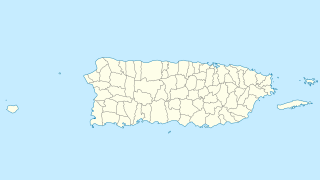 W
WThe Torréns Bridge is a historic bridge over the Rosario River in Hormigueros municipality, Puerto Rico. It was built in 1878 in a beam bridge structure with lattice girders and transverse joists, a design unique in the later territory of the United States. It is named for Modesto Torréns Morales, mayor of Hormigueros from 1875 to 1879, during a period when the municipality advocated for improved transportation linkages from the settlement of Hormigueros to the rest of the island. Improvement of the difficult Rosario River crossing on the road from the town to the main highway south of the river was seen as critical to economic development, especially after Hormigueros municipality separated from San Germán in 1874. In 1898 during the Spanish–American War, the Torréns Bridge was captured by the U.S. Army to aid its advance during the Battle of Hormigueros and subsequent march on Mayagüez.
 W
WThe Treaty of Paris of 1898 was a treaty signed by Spain and the United States on December 10, 1898, that ended the Spanish–American War. Under it, Spain relinquished all claim of sovereignty over and title to Cuba and also ceded Puerto Rico, Guam, and the Philippines to the United States. The cession of the Philippines involved a compensation of $20 million from the United States to Spain.
 W
WThe United Spanish War Veterans was an American veterans organization which consisted of veterans of the Spanish–American War, Philippine–American War and China Relief Expedition.
 W
WOn 25 April 1898, the United States Congress declared war upon Spain. The ensuing Spanish–American War resulted in a decisive victory for the United States, and arguably served as a transitional period for both nations. Spain saw its days of empire fade, as the United States saw the prospect of overseas empire emerge. The war was ended by the Treaty of Paris signed on December 10 that same year.
 W
WThe War Revenue Act of 1898 was legislation signed into law in the United States on June 13, 1898, which created a wide range of taxes to raise revenue for the American prosecution of the Spanish–American War. The legislation established the predecessor to the estate tax, and twice the Supreme Court of the United States issued rulings about the law.
 W
WWater cure is a form of torture in which the victim is forced to drink large quantities of water in a short time, resulting in gastric distension, water intoxication, and possibly death.
 W
WThe Women's National War Relief Association was an American relief organization founded during the Spanish–American War to give comfort to the officers, soldiers and sailors in the United States Military. The women founding the association used the group as a means for women "to supplement with material aid the sacrifices of time, strength, and life made by the men of the nation" during the military conflict.